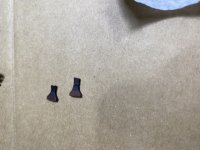Right. If you have the option, it might be better to look for one in better condition. If not, at least double-check that there is no continuity between the commutator and the shaft (which would indicate a shorted winding). Ideally, the armature would be checked on a "growler", but I have no idea where you would find one today. (I bought an old one on eBay, but it will need to be refurbished before I can use it, and I'm quarantined 2000 miles away. )
And the less you can disturb those windings, the better. So I would probably try to glue the old pieces back, as many as you can find. They are just cushions really, to help keep the edge of the lamination from cutting through the enamel on the wires; not otherwise important to operation.
Try to work a little epoxy under the ones that aren't broken, too. Might help keep them from breaking in the future.

 I disassembled my wiper motor to clean and refurbish. As I was cleaning the armature I noticed these little bits of fiberboard were falling out from under the windings. Most of them are still tightly embedded under the windings but I don’t want them to come out after I reassemble the motor. Any advice on how to get them to stay in place?
I disassembled my wiper motor to clean and refurbish. As I was cleaning the armature I noticed these little bits of fiberboard were falling out from under the windings. Most of them are still tightly embedded under the windings but I don’t want them to come out after I reassemble the motor. Any advice on how to get them to stay in place?
 Hi Guest!
Hi Guest!

 smilie in place of the real @
smilie in place of the real @
 Pretty Please - add it to our Events forum(s) and add to the calendar! >>
Pretty Please - add it to our Events forum(s) and add to the calendar! >> 
